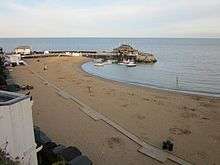The Mary White was a lifeboat based in Broadstairs, Kent, England, named in 1851 after the completion of an heroic rescue of a brig, the Mary White.
Such was the bravery displayed by the lifeboat crew on this occasion that it excited a great deal of enthusiasm throughout Kent and a ballad, the Song of the Mary White, was composed to honour the men involved.
1851 rescue
As recited in the ballad written to commemorate the occasion, the then unnamed lifeboat, which had only recently (July 1850) been presented to Broadstairs by the shipwright Thomas White, saw its first use on 6 March 1851.
On this occasion, the brig Mary White became trapped upon the Goodwin Sands during a very severe gale blowing from the north. In response to the sight of the ship in distress the Harbour Master, Coxswain Solomon Holbourn, mustered a crew for the lifeboat.
The new vessel was launched into the surf, from its horse-drawn wagon-trailer as was the method of the times. It was a bitterly cold morning as the crew struggled against the high winds, hailstones, sleet and snow, to reach the stricken ship. After a while they were able to get close and cast a line to the Mary White and succeeded in getting seven of the ten crewmen aboard, to the relative safety of the lifeboat.
The Harbour Master and another of the lifeboat crew, George Castle, were on the Mary White with the ship's captain and the two others remaining of her crew, when the rope snapped and the lifeboat broke away from the wreck, which was rapidly going to pieces, soon to be devoured by the ‘Shippe Swallower’ (Goodwin Sands).
The Second Coxswain signalled that he was unable to get alongside the wreck, and that those left on the Mary White were at the mercy of God and the sea. Captain White remained with his ship, and the lifeboat men were unable to persuade the remaining two to abandon their captain or trust themselves to the waves. The Harbour Master and other lifeboat men had no option but to make a swim for it, or face certain doom. Castle and Holbourn jumped into the maelstrom and made it to the lifeboat, whereupon, every option exhausted, the valiant band turned and rowed to shore.
Aftermath
This then, was the first lifeboat that had saved lives from the Goodwin Sands. Due to the strange coincidence of the recurrence of the names White, from Thomas and John the lifeboat builders, and the name of the brig Mary White',' and also from the name of its captain, Mr White, the lifeboat was thereafter named Mary White.
The RNLI also made a special award of silver medals for gallantry to all eight members of the crew. So pleased was John White, that he presented Broadstairs with its second lifeboat shortly afterwards; this was named the ‘Culmer White’.
This itself gives testimony to the link by marriage between Mary Culmer, daughter of George Culmer the owner of the shipyard, and John White (Vth) in 1721, then a shipwright, whose family can be traced back to 1583.[1]
Jeff Morris, Honorary Archivist to the Lifeboat Enthusiasts' Society, explains that Coxswain Jethro Pettit also received an RNLI Silver Medal, this being on the occasion of his retirement after the Rescue of the brig Mary White, Broadstairs, 1851.
Rescue of the crew of the Northern Bell

Rescue of the crew of the Northern Belle 1857
The Mary White and the Culmer White were later used in the rescue of the crew of the Northern Belle, an American transatlantic ship which ran aground near Thanet, England, on January 5, 1857. No lives were lost, thanks to heroic rescue efforts in blizzard conditions.
Local historian William Lapthorne described the events of the rescue:
"On arrival at the beach the boats were launched, and with a total disregard for their own safety, the crews pulled boldly through the boiling surf and, after making several hazardous trips, saved most of the crew of the stricken vessel.
"The Mary White, having been dragged across fields of snow, was able to bring off seven of the American crew, and then the Culmer White, having arrived with a fresh crew, made two further journeys, on the first attempt rescuing fourteen shipwrecked men, and only then returning to recover the Captain and the Pilot."
See also
Notes and references
- ↑ ‘The Whites were a family which had its roots in local Shipbuilding during the days of the Spanish Armada when they provided vitally needed supplies to the English Fleet anchored off Broadstairs in 1588.’ : ‘The Maritime Heritage of Thanet’ 1997 : W. Lapthorne Ed. : Michael Cates and Diane Chamberlain. (East Kent Maritime Trust.)
Coordinates: 51°21′27″N 1°26′38″E / 51.35750°N 1.44389°E / 51.35750; 1.44389


